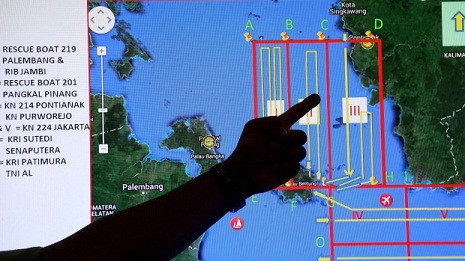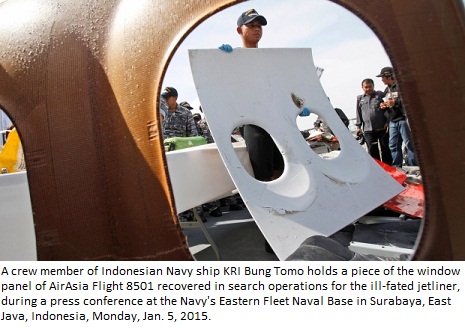This week, divers and an unmanned underwater vehicle were able to capture the first images of the wreck. The tail of the Airbus A320, partially buried in the sand of the shallow waters, provided a boost to searchers. However, poor weather made it impossible for divers to get a closer look. Officials are confident the cockpit voice and flight data recorders are still in the aircraft`s rear, and experts hope to use a crane or a lifting balloon to hoist the wreckage from the seabed.

Wreckage identified as AirAsia Flight 8501, in the Java Sea, Indonesia.
CRASH INVESTIGATION:
It remains unclear what caused Flight 8501 to go down. The last contact the pilots had with air traffic control indicated they were entering stormy weather. They asked to climb from 32,000 feet to 38,000 feet to avoid threatening clouds, but were denied permission because of heavy air traffic above them. Four minutes later, the plane dropped off the radar. Floating bodies and pieces of debris were found about 10 kilometres (6 miles) from the last point of contact. The black boxes are key to the investigation.

A member of the Indonesian National Search and Rescue Agency (BASARNAS) points to a map of a search area for missing AirAsia Flight 8501, at Pangkal Pinang command post in Sumatra Island, Monday, Dec. 29, 2014.
STATUS OF THOSE MISSING:
So far, 48 of the 162 passengers and crew on board the plane have been recovered, with four new bodies discovered Friday. A few have been found floating while still strapped to their seats, but officials say many of those still missing are likely entombed in the fuselage. The bodies are sent to Surabaya for identification and handed over to their families for burial, but the process is becoming more difficult due to decomposition.

Members of the National Search And Rescue Agency carry coffins containing bodies of the victims aboard AirAsia Flight 8501 to transfer to Surabaya at the airport in Pangkalan Bun, Indonesia, Friday, Jan. 2, 2015.
CRASH LOCATION:
The plane went down in the Java Sea, with bodies and wreckage found about 160 kilometres from Pangkalan Bun on Borneo island, the closest town. The area is being lashed by seasonal rains, causing big waves and murky runoff from rivers that have hampered divers, helicopters and equipment being used to search for the plane. Ships with sonar detectors have identified several large chunks of what is believed to be the plane`s body on the ocean floor, but visuals have not been captured.

Divers on a rubber boat conduct their search operation for the victims of AirAsia flight QZ 8501at Java Sea, Indonesia, Sunday, Jan. 4, 2015.
More about:















































